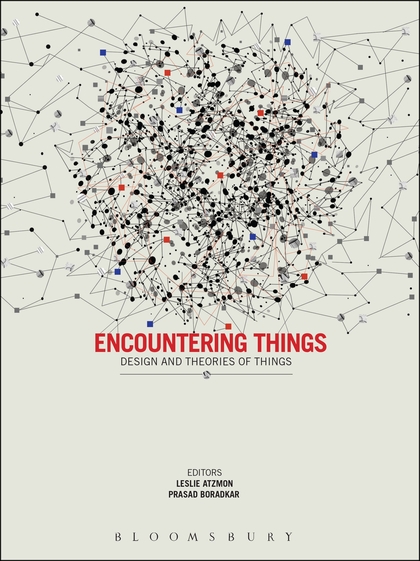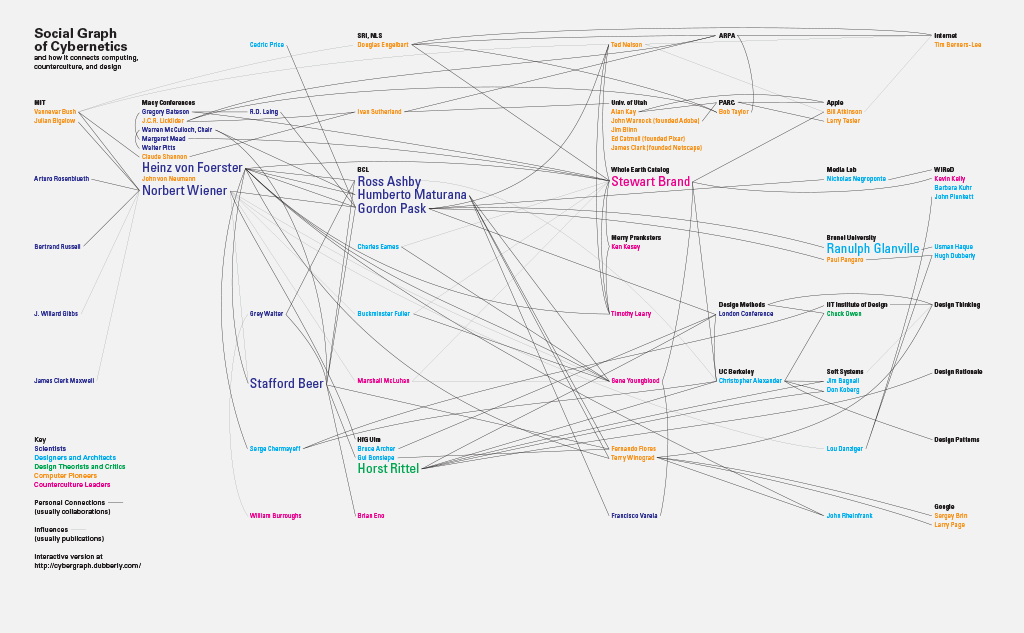-
Dubberly Design Office
2501 Harrison Street, No. 7
San Francisco, CA 94110 -
415 648 9799 phone
415 648 9899 fax
Articles
Connecting things: Broadening design to include systems, platforms, and product-service ecologies

Encountering Things: Design and Theories of Things, edited by Leslie Atzmon & Prasad Boradkar, Bloomsbury 2017.
Traditionally, design practice and design education have focused on giving form to physical things—apparel, buildings, messages, tools, and vehicles—the artifacts that constitute material culture. These artifacts are also the material of the traditional design disciplines—apparel design, architecture, graphic design, product design, and transportation design.
Distinguishing between control and collaboration—and communication and conversation
In their paper “from Autonomous Systems to Sociotechnical Systems: Designing Effective Collaborations,” Kyle J. Behymer and John M. Flach remind us “the goal of design is a seamless integration of human and technological capabilities into a well-functioning socialtechnical system.”1 Recent trends—the sensor revolution, big data, machine learning, and intelligent agents, for example—make their reminder timely.
Cybernetics and Design: Conversations for Action
Working for decades as both theorist and teacher, Ranulph Glanville came to believe that cybernetics and design are two sides of the same coin.
Working as both practitioners and teachers, the authors present their understanding of Glanville and the relationships between cybernetics and design.
We believe cybernetics offers a foundation for 21st-century design practice. We offer this rationale:
– If design, then systems: Due in part to the rise of computing technology and its role in human communications, the domain of design has expanded from *giving form* to *creating systems* that support human interactions; thus, systems literacy becomes a necessary foundation for design.
– If systems, then cybernetics: Interaction involves goals, feedback, and learning, the science of which is cybernetics.
– If cybernetics, then second-order cybernetics: Framing wicked problems requires explicit values and viewpoints, accompanied by the responsibility to justify them with explicit arguments, thus incorporating subjectivity and the epistemology of second-order cybernetics.
– If second-order cybernetics, then conversation: Design grounded in argumentation requires conversation so that participants may understand, agree, and collaborate on effective action.
Second-order cybernetics frames design as conversation for learning together, and second-order design creates possibilities for others to have conversations, to learn, and to act.
— Hugh Dubberly[1] and Paul Pangaro[2]
How cybernetics connects computing, counterculture, and design
*Written by Hugh Dubberly and Paul Pangaro. Originally published by the Walker Art Center in the catalog for the exhibit Hippie Modernism: The Struggle for Utopia.*
“Man is always aiming to achieve some goal and he is always looking for new goals.”
— Gordon Pask[1]
A Systems Literacy Manifesto
In 1968, West Churchman wrote, “…there is a good deal of turmoil about the manner in which our society is run. …the citizen has begun to suspect that the people who make major decisions that affect our lives don’t know what they are doing.”[1] Churchman was writing at a time of growing concern about war, civil rights, and the environment. Almost fifty years later, these concerns remain, and we have more reason than ever “to suspect that the people who make major decisions that affect our lives don’t know what they are doing.” Examples abound.
VoteStream: Turning Elections Data into Open Data
*Written for DMI magazine — Summer 2014.*
*US elections technology—the infrastructure on which democracy depends—is proprietary,
locking up public data; unlocking that data is a design challenge on many levels.*
— Hugh Dubberly
Systemic and meta-systemic laws
*With the publication of The Tree of Knowledge: The Biological Roots of Human Understanding, Humberto Maturana established himself as an important figure in the history of systems thinking. His essay “Metadesign” is a strong argument against technological determinism and points to our responsibility for the world we create; it should be required reading for all design students.*
*Over the past several years, Maturana (now 84) has collaborated with Ximena Dávila to produce a set of essays on “human biological-cultural living,” which have not been translated into English. At the heart of the book are 30 “laws” that summarize much of their thinking about biological and cultural systems. These laws provide insights for managers, designers, teachers, and students grappling with challenges in a world in which all forms of design (and especially software and service design) increasingly require systems thinking. Everyone interested in systems thinking should study these laws.*
*As Maturana and Dávila have noted, their “systemic and meta-systemic laws are not definitions, ontological assumptions, or a priori principles, they are abstractions of the operation of systems in the different sensory-operational-relational domains in which we distinguish them.”*
— Hugh Dubberly, Editor
The problem with transparency is that it’s not conspicuous enough
*This article proposes a model of transparency, the idea that a good tool “disappears” in the hands of skilled users. The article then proposes a model of design as the management of a dynamic transparency. In use, we often want a tool to be transparent, but other times, in the show room or in front of guests for example, we may want the tool to call attention to itself. And finally, the article argues that design theory (and presumably design models) are best when they too are transparent.*
— Hugh Dubberly, Editor
More…
Coherence and responsiveness
This article presents a model of the trade-offs between responsiveness and coherence often found in designing and managing systems. The model also describes how both responsiveness and coherence often decline as a system grows. The authors argue that designers need not accept a zero-sum or least-bad choice but rather should seek platform improvements and collaboration tools that increase both responsiveness and coherence.
— Hugh Dubberly, Editor
What can Steve Jobs and Jonathan Ive teach us about designing?
*Written for Interactions Magazine*
The day after Steve Jobs died, my friend Rich Binell, another Apple alum, asked, “Why did Steve Jobs’ passing affect us more than the passing of other notable people?” Of course, Jobs changed the world, and many of us were moved by his work.
How did he do it?
